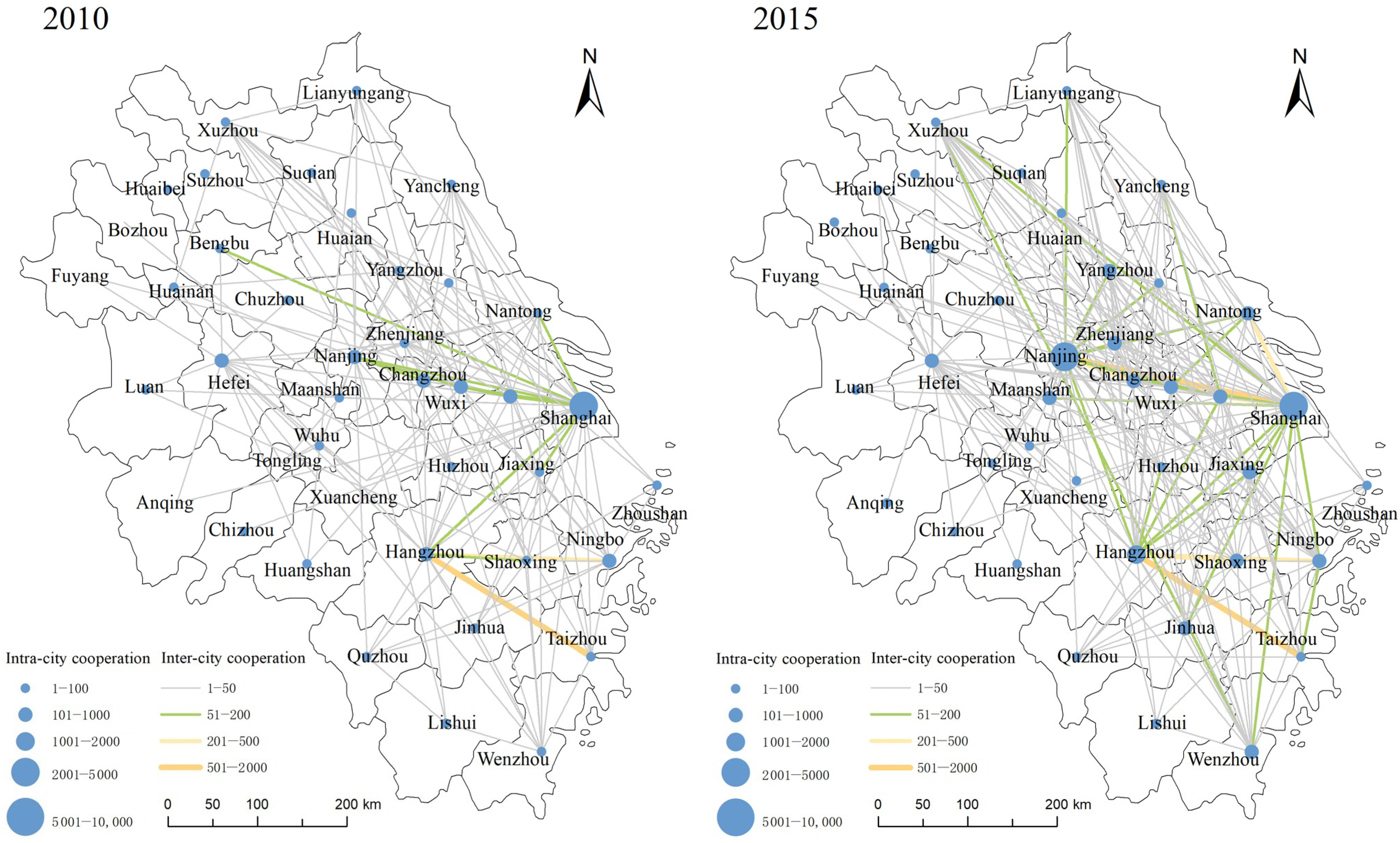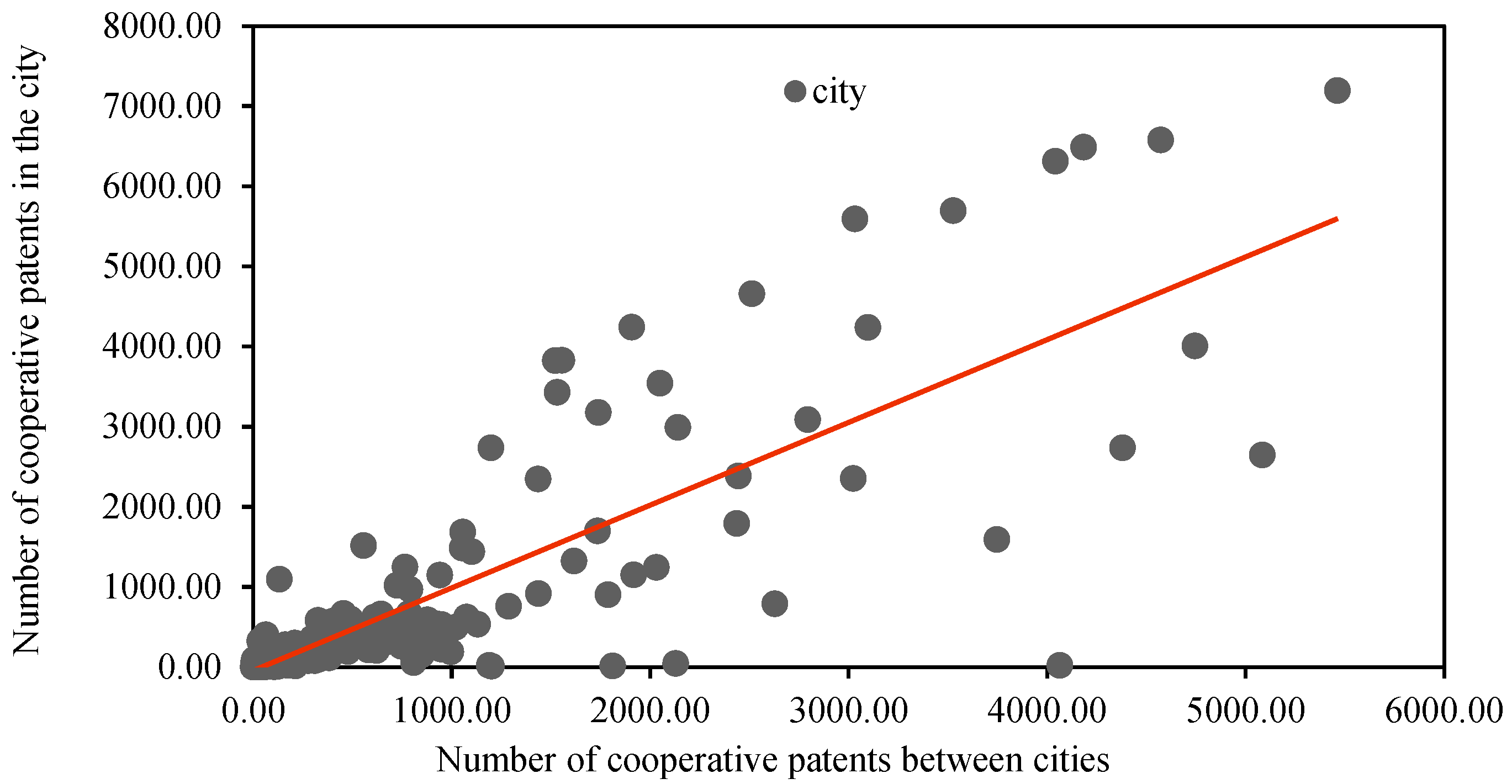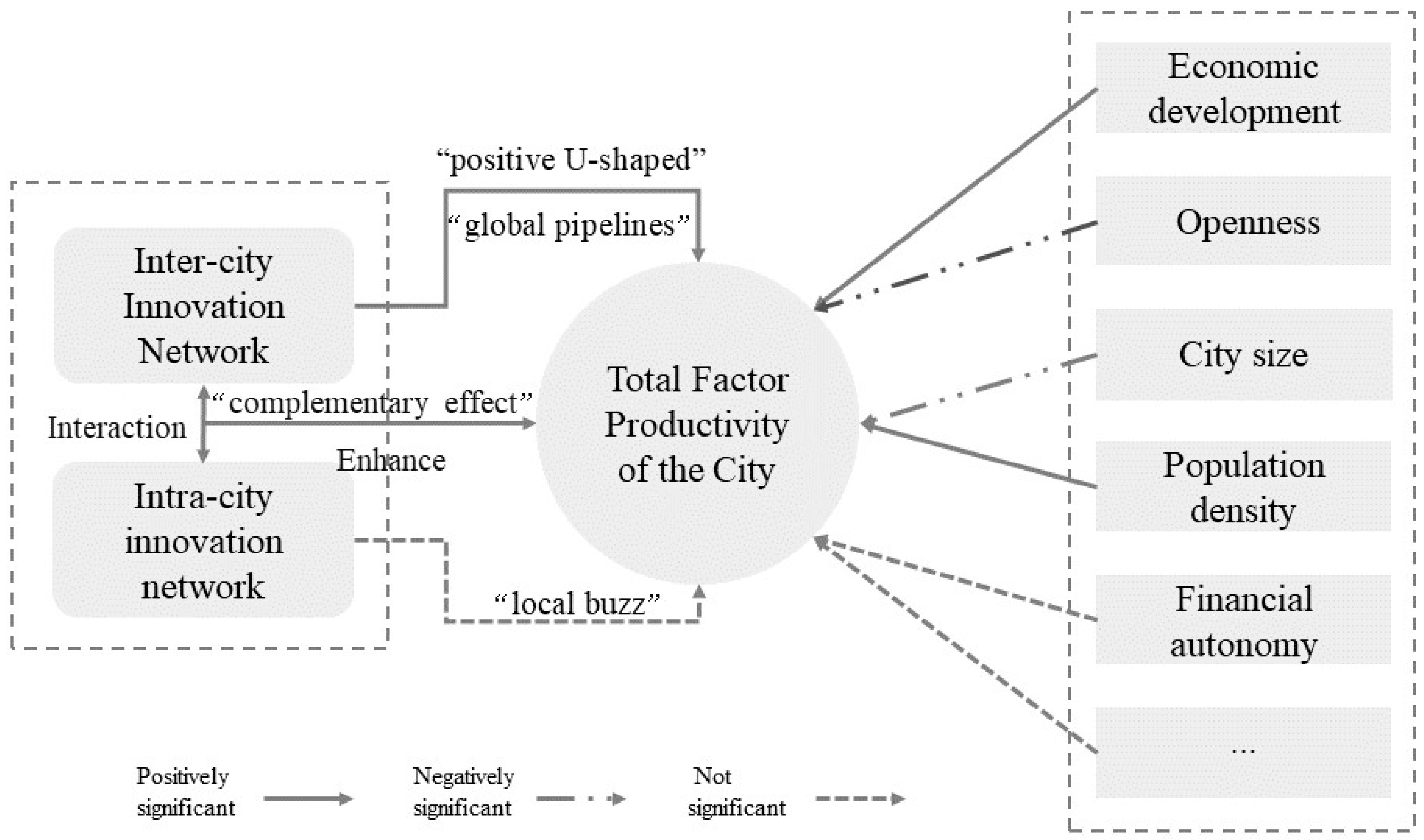The Impact of Intra-City and Inter-City Innovation Networks on City Economic Growth: A Case Study of the Yangtze River Delta in China
Abstract
:1. Introduction
2. Literature Review
2.1. Relationship between Innovation Networks and Economic Growth
2.2. Influence of Innovation Networks on City Economic Growth
3. Methods and Data
3.1. Research Sample
3.2. Calculation of Innovation Networks in the Yangtze River Delta
3.3. Calculation Method of Economic Growth in the Yangtze River Delta
3.3.1. Total Factor Productivity of DEA Malmquist Index
3.3.2. The Input–Output Index System
4. Results Analysis
4.1. Characteristics of Innovation Networks in the Yangtze River Delta Region
4.2. Temporal and Spatial Evolution Characteristics of Economic Growth in the Yangtze River Delta
5. Influence Mechanism
5.1. Model Construction and Variable Selection
5.2. Analysis of Model Regression Results
6. Discussion and Conclusions
Author Contributions
Funding
Data Availability Statement
Conflicts of Interest
References
- Gluckler, J. How controversial innovation succeeds in the periphery? A network perspective of BASF Argentina. J. Econ. Geogr. 2014, 14, 903–927. [Google Scholar] [CrossRef]
- Fernandes, C.; Farinha, L.; Ferreira, J.J.; Asheim, B.; Rutten, R. Regional innovation systems: What can we learn from 25 years of scientific achievements? Reg. Stud. 2020, 55, 377–389. [Google Scholar] [CrossRef]
- Bathelt, H.; Cantwell, J.A.; Mudambi, R. Overcoming frictions in transnational knowledge flows: Challenges of connecting, sense-making and integrating. J. Econ. Geogr. 2018, 18, 1001–1022. [Google Scholar] [CrossRef]
- Denney, S.; Southin, T.; Wolfe, D.A. Entrepreneurs and cluster evolution: The transformation of Toronto’s ICT cluster. Reg. Stud. 2021, 55, 196–207. [Google Scholar] [CrossRef]
- Antonelli, C. Localised Technological Change: Towards the Economics of Complexity; Routledge: London, UK, 2011. [Google Scholar]
- Mahmood, N.; Zhao, Y.; Lou, Q.; Geng, J. Role of environmental regulations and eco-innovation in energy structure transition for green growth: Evidence from OECD. Technol. Forecast. Soc. Chang. 2022, 183, 121890. [Google Scholar] [CrossRef]
- Aghion, P.; Howitt, P. Endogenous Growth Theory; MIT Press: Cambridge, MA, UK, 1998. [Google Scholar]
- Roberts, M.; Setterfield, M. Endogenous regional growth: A critical survey. In Handbook of Alternative Theories of Economic Growth; Setterfield, M., Ed.; Edward Elgar: Cheltenham, UK, 2010. [Google Scholar]
- Capello, R.; Caragliu, A.; Fratesi, U. Breaking down the border: Physical, institutional and cultural obstacles. Econ. Geogr. 2018, 94, 485–513. [Google Scholar] [CrossRef]
- Ramadani, V.; Gërguri, S.; Rexhepi, S. Innovation and economic development: The case of FYR of macedonia. J. Balk. Near East. Stud. 2013, 15, 324–345. [Google Scholar] [CrossRef]
- Huggins, R.; Thompson, P. Networks and regional economic growth: A spatial analysis of knowledge ties. Environ. Plan. A 2017, 49, 1247–1265. [Google Scholar] [CrossRef] [Green Version]
- Esposito, C.R.; Rigby, D.L. Buzz and pipelines: The costs and benefits of local and nonlocal interaction. J. Econ. Geogr. 2019, 19, 753–773. [Google Scholar] [CrossRef]
- Buciuni, G.; Pisano, G. Knowledge integrators and the survival of manufacturing clusters. J. Econ. Geogr. 2018, 18, 1069–1089. [Google Scholar] [CrossRef]
- Crespo, J.; Suire, R.; Vicente, J. Lock-in or lock-out? How structural properties of knowledge networks affect regional resilience. J. Econ. Geogr. 2014, 14, 199–219. [Google Scholar] [CrossRef] [Green Version]
- Breschi, S.; Lissoni, F.; Miguelez, E. Foreign-origin inventors in the USA: Testing for diaspora and brain gain effects. J. Econ. Geogr. 2017, 17, 1009–1038. [Google Scholar] [CrossRef]
- Bathelt, H.; Malmberg, A.; Maskell, P. Clusters and knowledge: Local buzz, global pipelines and the process of knowledge creation. Prog. Hum. Geogr. 2004, 28, 31–56. [Google Scholar] [CrossRef]
- Storper, M. Separate worlds? Explaining the current wave of regional economic polarization. J. Econ. Geogr. 2018, 18, 247–270. [Google Scholar] [CrossRef]
- Galaso, P.; Kovářík, J. Collaboration networks, geography and innovation: Local and national embeddedness. Pap. Reg. Sci. 2021, 100, 349–377. [Google Scholar] [CrossRef]
- Bianchi, C.; Galaso, P.; Palomeque, S. The trade-offs of brokerage in inter-city innovation networks. Reg. Stud. 2021, 19, 36–64. [Google Scholar] [CrossRef]
- Operti, E.; Kumar, A. Too much of a good thing? Network brokerage within and between regions and innovation performance. Reg. Stud. 2023, 57, 300–316. [Google Scholar] [CrossRef]
- Le Gallo, J.L.; Plunket, A. Regional gatekeepers, inventor networks and inventive performance: Spatial and organizational channels. Res. Policy 2020, 49, 103981. [Google Scholar] [CrossRef]
- Boschma, R. Proximity and innovation: A critical assessment. Reg. Stud. 2005, 39, 61–74. [Google Scholar] [CrossRef]
- Cao, X.; Zeng, G.; Ye, L. The structure and proximity mechanism of formal innovation networks: Evidence from Shanghai high-tech ITISAs. Growth Chang. 2019, 50, 569–586. [Google Scholar] [CrossRef]
- Balland, P.A.; Boschma, R. Complementary interregional linkages and Smart Specialisation: An empirical study on European regions. Reg. Stud. 2021, 55, 1059–1070. [Google Scholar] [CrossRef]
- Boschma, R. Relatedness as driver of regional diversification: A research agenda. Reg. Stud. 2017, 51, 351–364. [Google Scholar] [CrossRef]
- Cicerone, G.; McCann, P.; Venhorst, V.A. Promoting regional growth and innovation: Relatedness, revealed comparative advantage and the product space. J. Econ. Geogr. 2020, 20, 293–316. [Google Scholar] [CrossRef] [Green Version]
- Huggins, R.; Thompson, P. A Network-based view of regional growth. J. Econ. Geogr. 2014, 14, 511–545. [Google Scholar] [CrossRef] [Green Version]
- Prabhakaran, T.; Lathabai, H.H.; Changat, M. Detection of paradigm shifts and emerging fields using scientific network: A case study of information technology for engineering. Technol. Forecast. Soc. Chang. 2015, 91, 124–145. [Google Scholar] [CrossRef]
- Ter Wal, A.L.J. Cluster emergence and network evolution: A longitudinal analysis of the inventor network in sophia-antipolis. Reg. Stud. 2013, 47, 651–668. [Google Scholar] [CrossRef] [Green Version]
- Patra, S.K.; Muchie, M. An assessment of south african technological capability using patent data from WIPO patentscope database. Afr. J. Sci. Technol. Innov. Dev. 2022, 14, 333–340. [Google Scholar] [CrossRef]
- Wang, S.; Wang, J.; Wei, C.; Wang, X.; Fan, F. Collaborative innovation efficiency: From within cities to between cities—Empirical analysis based on innovative cities in China. Growth Chang. 2021, 52, 1330–1360. [Google Scholar] [CrossRef]
- Fare, R.; Grosskopf, S.; Norris, M.; Zhang, Z. Productivity growth, technical progress, and efficiency changes in industrialized countries. Am. Econ. Rev. 1994, 84, 66–83. [Google Scholar]
- McCombie, J.S.; Spreafico, M.R. Kaldor’s ‘technical progress function’ and verdoorn’s law revisited. Camb. J. Econ. 2015, 40, 1117–1136. [Google Scholar] [CrossRef]
- Rombach, M.P.; Porter, M.A.; Fowler, J.H.; Mucha, P.J. Core-periphery structure in networks. Siam J. Appl. Math. 2014, 74, 167–190. [Google Scholar] [CrossRef] [Green Version]
- Zhang, W.J.; Thill, J.C. Mesoscale structures in world city networks. Ann. Am. Assoc. Geogr. 2019, 109, 887–908. [Google Scholar] [CrossRef]
- Zhang, W.; Derudder, B.; Wang, J.; Witlox, F. An analysis of the determinants of the multiplex urban networks in the Yangtze River delta. Tijdschr. Voor Econ. En Soc. Geogr. 2020, 111, 117–133. [Google Scholar] [CrossRef]
- Huang, Z.J.; He, C.F. Industrial Innovation Investments and the Quality of Urban Economic Growth in China. China Soft Sci. 2013, 3, 89–100. [Google Scholar]
- Trippl, M.; Grillitsch, M.; Isaksen, A. Exogenous sources of regional industrial change: Attraction and absorption of non-local knowledge for new path development. Prog. Hum. Geogr. 2018, 42, 687–705. [Google Scholar] [CrossRef]
- Wen, H.; Zhang, Q.G.; Zhu, S.Z.; Huang, Y.Y. Inter- and intra-city networks: How networks are shaping China’s film industry. Reg. Stud. 2021, 55, 533–545. [Google Scholar] [CrossRef]
- Vale, M.; Carvalho, L. Knowledge networks and processes of anchoring in portuguese biotechnology. Reg. Stud. 2013, 47, 1018–1033. [Google Scholar] [CrossRef] [Green Version]
- Boschma, R.; Iammarino, S. Related variety, trade linkages, and regional growth in Italy. Econ. Geogr. 2009, 85, 289–311. [Google Scholar] [CrossRef]







| Indicator Type | Secondary Indicator | Measure Indicators |
|---|---|---|
| Input indicator | Capital | Social fixed-assets investment |
| Land | Built-up area of each city | |
| Labor | The sum of employees in urban units and private and individual employees | |
| Output indicator | The economic output | GDP |
| 2010 | 2019 | ||
|---|---|---|---|
| Partner Cities | Cooperation Scale (Pieces) | Partner Cities | Cooperation Scale (Pieces) |
| Hangzhou–Taizhou | 1149 | Hangzhou–Ningbo | 1327 |
| Hangzhou–Ningbo | 213 | Shanghai–Suzhou | 1118 |
| Hangzhou–Shanghai | 179 | Hangzhou–Taizhou | 785 |
| Shanghai–Suzhou | 178 | Jiaxing–Shanghai | 610 |
| Jiaxing–Shanghai | 125 | Nanjing–Suzhou | 594 |
| Nanjing–Shanghai | 117 | Nanjing–Shanghai | 562 |
| Shanghai–Wuxi | 98 | Hangzhou–Jinhua | 443 |
| Suzhou–Wuxi | 79 | Nanjing–Yangzhou | 421 |
| Nantong–Shanghai | 77 | Hangzhou–Shaoxing | 414 |
| Hangzhou–Shaoxing | 59 | Hangzhou–Shanghai | 394 |
| Variables | Symbol | Description | Mean | SD | Minimum | Maximum |
|---|---|---|---|---|---|---|
| Total factor productivity | TFP | Super-efficient total factor productivity | 0.821 | 0.181 | 0.421 | 1.865 |
| Inter-city cooperation | Inter | Number of cooperative patents between cities (piece) | 421.82 | 825.55 | 0 | 5463 |
| Intra-city cooperation | Intra | Number of cooperative patents in the city (piece) | 394.55 | 1010.1 | 0 | 7191 |
| Economic development | GDP | GDP per capita (CNY/person) | 67,051.6 | 32,818.7 | 9068 | 199,017 |
| Degree of openness | FDI | Foreign direct investment/GDP (%) | 0.463 | 0.368 | 0.029 | 2.853 |
| City size | Size | Population of the city (10,000 people) | 207.76 | 225.40 | 29 | 1469 |
| Population density | Dens | Population of the city/urban area (10,000 people/square kilometer) | 1.2762 | 0.5983 | 0.5630 | 3.8535 |
| Financial autonomy | GOV | Public budget revenue/public budget expenditure (%) | 0.641 | 0.232 | 0.069 | 1.116 |
| Model (1) | Model (2) | Model (3) | Model (4) | Model (5) | Model (6) | |
|---|---|---|---|---|---|---|
| LnTFP | LnTFP | LnTFP | LnTFP | LnTFP | LnTFP | |
| LnInter | 0.0294 | −0.314 ** | −0.0760 * | |||
| (0.0434) | (0.131) | (0.0443) | ||||
| LnIntra | −0.0628 | −0.0488 | −0.278 *** | |||
| (0.0409) | (0.124) | (0.0749) | ||||
| LnInter*LnIntra | 0.471 *** | |||||
| (0.11) | ||||||
| LnInter^2 | 0.478 *** | |||||
| (0.174) | ||||||
| LnIntra^2 | −0.0231 | |||||
| (0.162) | ||||||
| LnGDP | 0.0763 *** | 0.0756 *** | 0.0790 *** | 0.0796 *** | 0.0789 *** | 0.0803 *** |
| (0.0171) | (0.0172) | (0.0178) | (0.0174) | (0.0179) | (0.0179) | |
| LnFDI | −0.0243 *** | −0.0238 *** | −0.0249 *** | −0.0247 *** | −0.0250 *** | −0.0244 *** |
| (0.00637) | (0.00642) | (0.00646) | (0.00639) | (0.00649) | (0.00649) | |
| LnSize | −0.122 *** | −0.124 *** | −0.122 *** | −0.108 *** | −0.122 *** | −0.116 *** |
| (0.0282) | (0.0282) | (0.0283) | (0.0297) | (0.0285) | (0.0287) | |
| LnGOV | 0.0171 | 0.0169 | 0.0168 | 0.0125 | 0.017 | 0.0143 |
| (0.0179) | (0.0181) | (0.0178) | (0.0201) | (0.0178) | (0.0191) | |
| LnDens | 0.145 *** | 0.146 *** | 0.146 *** | 0.133 *** | 0.146 *** | 0.144 *** |
| (0.04) | (0.0398) | (0.0404) | (0.0402) | (0.0407) | (0.0402) | |
| constant | 0.573 *** | 0.582 *** | 0.580 *** | 0.443 *** | 0.583 *** | 0.536 *** |
| (0.142) | (0.144) | (0.141) | (0.161) | (0.144) | (0.144) | |
| Region fixed effect | Yes | Yes | Yes | Yes | Yes | Yes |
| Observations | 410 | 410 | 410 | 410 | 410 | 410 |
| R-squared | 0.688 | 0.688 | 0.688 | 0.694 | 0.688 | 0.695 |
| Model (7) | Model (8) | Model (9) | Model (10) | Model (11) | |
|---|---|---|---|---|---|
| L.LnTFP | L.LnTFP | L.LnTFP | L.LnTFP | L.LnTFP | |
| LnInter | 0.0542 | −0.310 ** | −0.0453 | ||
| (0.0469) | (0.137) | (0.0521) | |||
| LnIntra | −0.0533 | −0.0186 | −0.253 ** | ||
| (0.0523) | (0.164) | (0.0894) | |||
| LnInter*LnIntra | 0.420 *** | ||||
| (0.123) | |||||
| LnInter^2 | 0.505 *** | ||||
| (0.171) | |||||
| LnIntra^2 | −0.0581 | ||||
| (0.217) | |||||
| Control variables | Yes | Yes | Yes | Yes | Yes |
| constant | 0.538 *** | 0.514 ** | 0.371 | 0.524 ** | 0.497 * |
| (0.218) | (0.215) | (0.230) | (0.213) | (0.218) | |
| Region fixed effect | Yes | Yes | Yes | Yes | Yes |
| Observations | 369 | 369 | 369 | 369 | 369 |
| R-squared | 0.684 | 0.684 | 0.690 | 0.684 | 0.690 |
Disclaimer/Publisher’s Note: The statements, opinions and data contained in all publications are solely those of the individual author(s) and contributor(s) and not of MDPI and/or the editor(s). MDPI and/or the editor(s) disclaim responsibility for any injury to people or property resulting from any ideas, methods, instructions or products referred to in the content. |
© 2023 by the authors. Licensee MDPI, Basel, Switzerland. This article is an open access article distributed under the terms and conditions of the Creative Commons Attribution (CC BY) license (https://creativecommons.org/licenses/by/4.0/).
Share and Cite
Cao, X.; Chen, B.; Guo, Y.; Yi, Z. The Impact of Intra-City and Inter-City Innovation Networks on City Economic Growth: A Case Study of the Yangtze River Delta in China. Land 2023, 12, 1463. https://doi.org/10.3390/land12071463
Cao X, Chen B, Guo Y, Yi Z. The Impact of Intra-City and Inter-City Innovation Networks on City Economic Growth: A Case Study of the Yangtze River Delta in China. Land. 2023; 12(7):1463. https://doi.org/10.3390/land12071463
Chicago/Turabian StyleCao, Xianzhong, Bo Chen, Yi Guo, and Zhenzhen Yi. 2023. "The Impact of Intra-City and Inter-City Innovation Networks on City Economic Growth: A Case Study of the Yangtze River Delta in China" Land 12, no. 7: 1463. https://doi.org/10.3390/land12071463
APA StyleCao, X., Chen, B., Guo, Y., & Yi, Z. (2023). The Impact of Intra-City and Inter-City Innovation Networks on City Economic Growth: A Case Study of the Yangtze River Delta in China. Land, 12(7), 1463. https://doi.org/10.3390/land12071463






